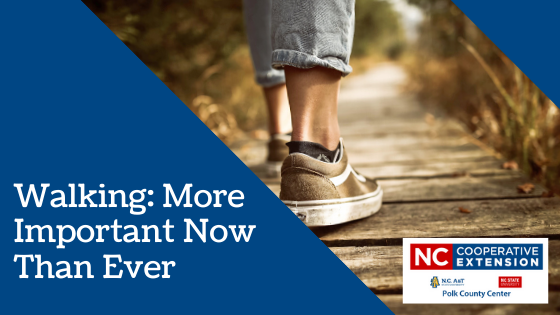Walking Is More Important Than Ever
go.ncsu.edu/readext?670398
en Español / em Português
El inglés es el idioma de control de esta página. En la medida en que haya algún conflicto entre la traducción al inglés y la traducción, el inglés prevalece.
Al hacer clic en el enlace de traducción se activa un servicio de traducción gratuito para convertir la página al español. Al igual que con cualquier traducción por Internet, la conversión no es sensible al contexto y puede que no traduzca el texto en su significado original. NC State Extension no garantiza la exactitud del texto traducido. Por favor, tenga en cuenta que algunas aplicaciones y/o servicios pueden no funcionar como se espera cuando se traducen.
Português
Inglês é o idioma de controle desta página. Na medida que haja algum conflito entre o texto original em Inglês e a tradução, o Inglês prevalece.
Ao clicar no link de tradução, um serviço gratuito de tradução será ativado para converter a página para o Português. Como em qualquer tradução pela internet, a conversão não é sensivel ao contexto e pode não ocorrer a tradução para o significado orginal. O serviço de Extensão da Carolina do Norte (NC State Extension) não garante a exatidão do texto traduzido. Por favor, observe que algumas funções ou serviços podem não funcionar como esperado após a tradução.
English
English is the controlling language of this page. To the extent there is any conflict between the English text and the translation, English controls.
Clicking on the translation link activates a free translation service to convert the page to Spanish. As with any Internet translation, the conversion is not context-sensitive and may not translate the text to its original meaning. NC State Extension does not guarantee the accuracy of the translated text. Please note that some applications and/or services may not function as expected when translated.
Collapse ▲
While North Carolina is under a shelter-in-place order, one of the approved exceptions for leaving ones home is to participate in outdoor recreation. And one of the easiest, least expensive, and social-distancing-friendly ways to do that is by getting outside and walking. It can be a walk through your neighborhood, on a woodland trail, along a paved track, or even just back and forth across your backyard. Wherever you feel safe, able to keep at least six feet distance from other people, and is approved for walking is just fine.
Not only is walking great for your health, but it’s good for your psyche, too. We are all under stress during the COVID-19 crisis, so getting outside and paying attention to the natural world can allow us to put our minds on something besides the news at hand. Here are some other great reminders about that daily walk.
Think baby steps. If you have not been active for a while, don’t feel like you have to immediately walk for miles. Start slowly, but be consistent. Walk every day even if it is only a block or two at first.
Start walking 10 minutes at a time. Think 5 minutes out and 5 minutes back. See how far you walked in those five minutes and remember where you were when you turned around to head back. As little as ten minutes of physical activity does provide health benefits such as: feeling better about yourself, less chance of being depressed, better sleep quality, stronger muscles and bones, and better range of motion.
Posture perks. As you are walking, think about your posture. Keep your head up, tummy in, and shoulders relaxed. Swing your arms naturally. Select your own comfortable, natural step length.
Remember to breathe! You should be able to talk while you are walking if you can’t, you may want to slow down.
Speed and distance. At first, don’t even think about your speed or your distance. Just getting outside and doing it is the important thing. As you get used to the 10 minute walk, you will begin to notice you can walk further in 10 minutes. Once you are comfortable walking 10 minutes, start slowly increasing the time you walk until you can comfortably walk 30 minutes every day. Three 10 minute walks are the same as one 30 minute walk. Do what fits best in your schedule.
Walking and safety. As you walk, be safe. Watch for traffic; it is best to walk on sidewalks if at all possible. Only walk in areas that are familiar to you. If you experience joint pain after walking, especially if it lasts longer than a couple of hours, it would be a good idea to check with your doctor to see what is causing the pain. It might be something simple like needing better shoes or it could be you should change to a different form of exercise.
Reward yourself. Finally, reward yourself after your walk. Is there a friend you are eager to Facetime with? Is there a show you’ve been streaming and you are looking forward to the next episode? Hold off on those things until you’ve gotten back from your walk and then use them as a simple gift to yourself for following through.
Walking has always been a terrific way to keep in shape and relieve stress. Now, that we are facing a potential long-term quarantine in our state, however, it is an activity that is more important than ever. Let’s get walking!




